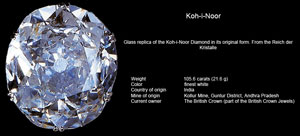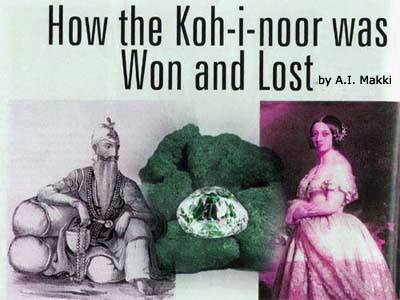Maharaja Ranjit Singh and kohinoor
The Kōh-i Nūr which means "Mountain of Light" in Persian, also spelled Koh-i-noor, Koh-e Noor or Koh-i-Nur, is a 105 carat (21.6 g) diamond (in its most recent cut) that was once the largest known diamond in the world. The Kōh-i Nūr originated in the state of Andhra Pradesh in India along with its double, the Darya-i-noor (the "Sea of Light"). It has belonged to various Hindu, Mughal, Turkic, Afghan, Sikh and British rulers who fought bitterly over it at various points in history and seized it as a spoil of war time and time again. It was finally seized by the East India Company and became part of the British Crown Jewels when Queen Victoria was proclaimed Empress of India in 1877.

Maharaja Ranjit Singh was crowned ruler of Punjab and willed the Koh-i-noor to the Jagannath Temple in Orissa from his deathbed in 1839. But after his death the British administrators did not execute his will. On 29 March 1849, the British raised their flag on the citadel of Lahore and the Punjab was formally proclaimed to be part of the British Empire in India. One of the terms of the Treaty of Lahore, the legal agreement formalising this occupation, was as follows:

The gem called the Koh-i-Noor which was taken from Shah Shuja-ul-Mulk by Maharajah Ranjit Singh shall be surrendered by the Maharajah of Lahore to the Queen of England.
The Governor-General in charge of the ratification for this treaty was Lord Dalhousie. More than anyone, Lord Dalhousie was responsible for the British acquiring the Koh-i-Noor, in which he continued to show great interest for the rest of his life. Dalhousie's work in India was primarily aimed at appropriation of Indian assets for the use of the British East India Company. His acquisition of the diamond, amongst many other things, was criticized even by some of his contemporaries in Britain. Although some suggested that the diamond should have been presented as a gift to the Queen, it is clear that Dalhousie felt strongly that the stone was a spoil of war, and treated it accordingly. Writing to his friend Sir George Cooper[disambiguation needed] in August of 1849, he stated:
The Court [of the East India Company] you say, are ruffled by my having caused the Maharajah to cede to the Queen the Koh-i-noor; while the 'Daily News' and my Lord Ellenborough [Governor-General of India, 1841-44 are indignant because I did not confiscate everything to her Majesty... [My] motive was simply this: that it was more for the honour of the Queen that the Koh-i-noor should be surrendered directly from the hand of the conquered prince into the hands of the sovereign who was his conqueror, than it should be presented to her as a gift—which is always a favour—by any joint-stock company among her subjects. So the Court ought to feel.
Dalhousie arranged that the diamond should be presented by Maharaja Ranjit Singh's young successor, Duleep Singh, to Queen Victoria in 1850. Duleep Singh was the youngest son of Ranjit Singh and his fifth wife Maharani Jind Kaur. Duleep, aged 13, travelled to the United Kingdom to present the jewel. The presentation of the Koh-i-Noor to Queen Victoria was the latest in the long history of transfers of the stone as a spoil of war. Duleep Singh had been placed in the guardianship of Dr Login. Login was a surgeon in the British Army who served in West Bengal, East India for some years and was a native of Southend, Stromness, Orkney Islands, Scotland. His family had run Login's Inn in Stromness since the early 19th century. Dr Login, his wife Lena and the young Duleep Singh travelled to England for the purpose of presenting the Koh-i-Noor diamond to Queen Victoria.
In due course the Governor-General received the Koh-i-Noor from Login, who had been appointed Governor of the Citadel, the Royal Fort at Lahore, with the Royal Treasury, which Login valued at almost £1,000,000 (£81.6 million as of 2011), excluding the Koh-i-Noor, on 6 April 1848, under a receipt dated 7 December 1849, in the presence of the members of the Board of Administration—the local resident H.M. Lawrence, C.C. Mansel, John Lawrence, younger brother of H.M. Lawrence, and of Sir Henry Elliot, Secretary to the Government of India. The jewel was then sent to England in the care of John Lawrence, and C.C. Mansel for presentation to Queen Victoria, sailing from Bombay in HMS Medea under strict security arrangements.

The ship had a difficult voyage—an outbreak of cholera on board when the ship was in Mauritius had the locals demanding its departure and they asked their governor to open fire and destroy the vessel if it did not respond. Shortly thereafter the vessel was hit by a severe gale that blew for some twelve hours. Legend in the Lawrence family has it that during the voyage, John Lawrence left the jewel in his waistcoat pocket when it was sent to be laundered, and it was returned promptly by the steward who found it.
On arrival in Britain the passengers and mail were unloaded in Plymouth, but the Koh-i-noor stayed on board until the ship reached Portsmouth, from where Lawrence and Mansel took the diamond to the East India House in the City of London and passed it into the care of the Chairman and Deputy Chairman of the EIC. The handing over of the Koh-i-Noor diamond to The Queen on 3 July 1850 as part of the terms of the conclusion of the Sikh War also coincided with the 250th anniversary of the EIC. Dr Login received a knighthood in 1854 from Queen Victoria and was known as Sir John Spencer Login (he had added the 'r' to his middle name to change it from Spence to Spencer). The diamond is now set into the crown worn by the female consort to Monarch of the United Kingdom, and is currently in the Crown of Queen Elizabeth (the late Queen Mother).
The Curse of the Koh-i-Noor
It is believed that the Koh-i-Noor carries with it a curse and only when in the possession of a woman will the curse not work. All the men who owned it have either lost their throne or had other misfortunes befall them. Queen Victoria is the only reigning monarch to have worn the gem. According to the legend, if the monarch is a male, the stone is passed to his spouse.
The possibility of a curse pertaining to ownership of the diamond dates back to a Hindu text relating to the first authenticated appearance of the diamond in 1306: "He who owns this diamond will own the world, but will also know all its misfortunes. Only God, or a woman, can wear it with impunity." All the owners of the Koh-i-noor have had a tragedy befall them.
